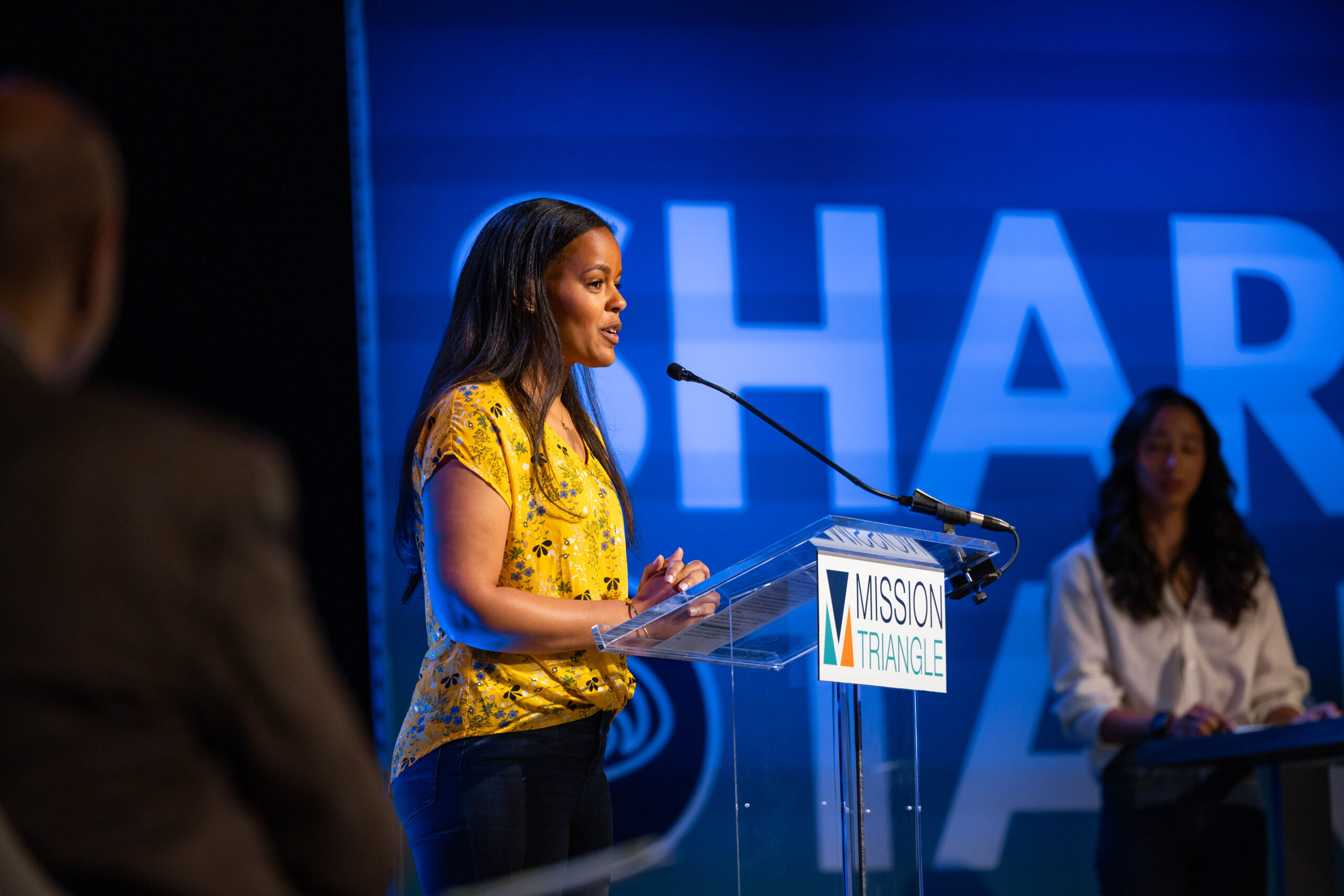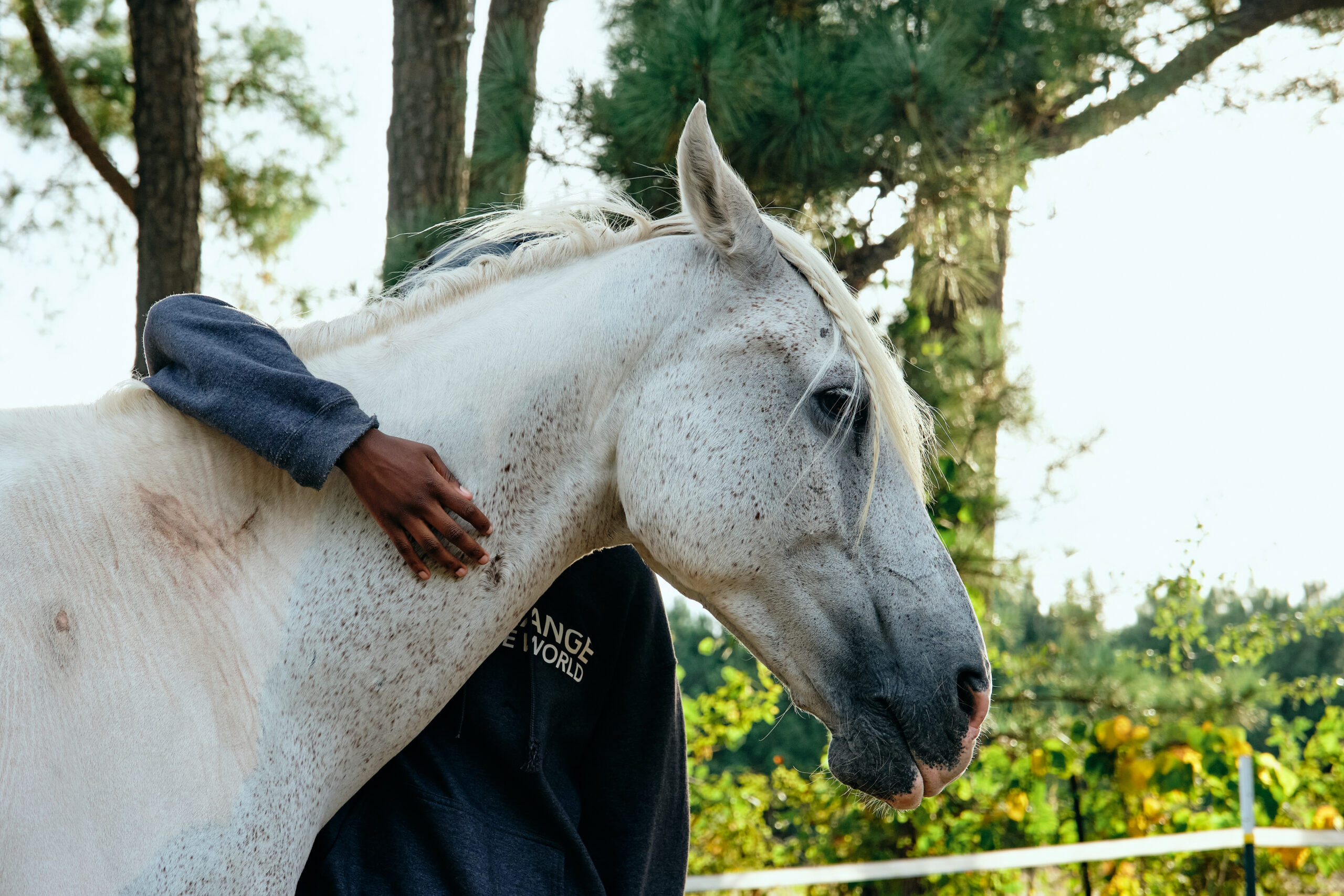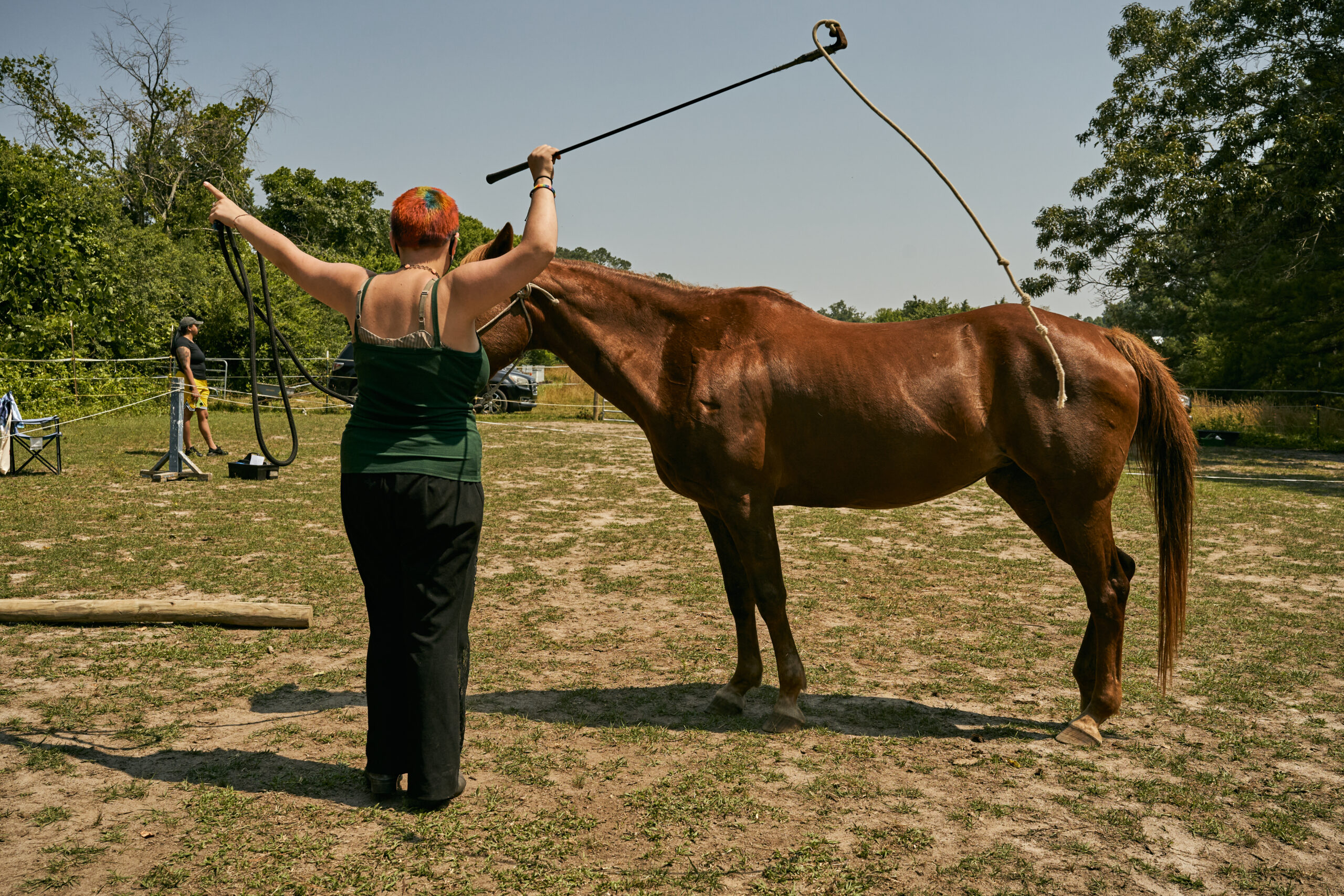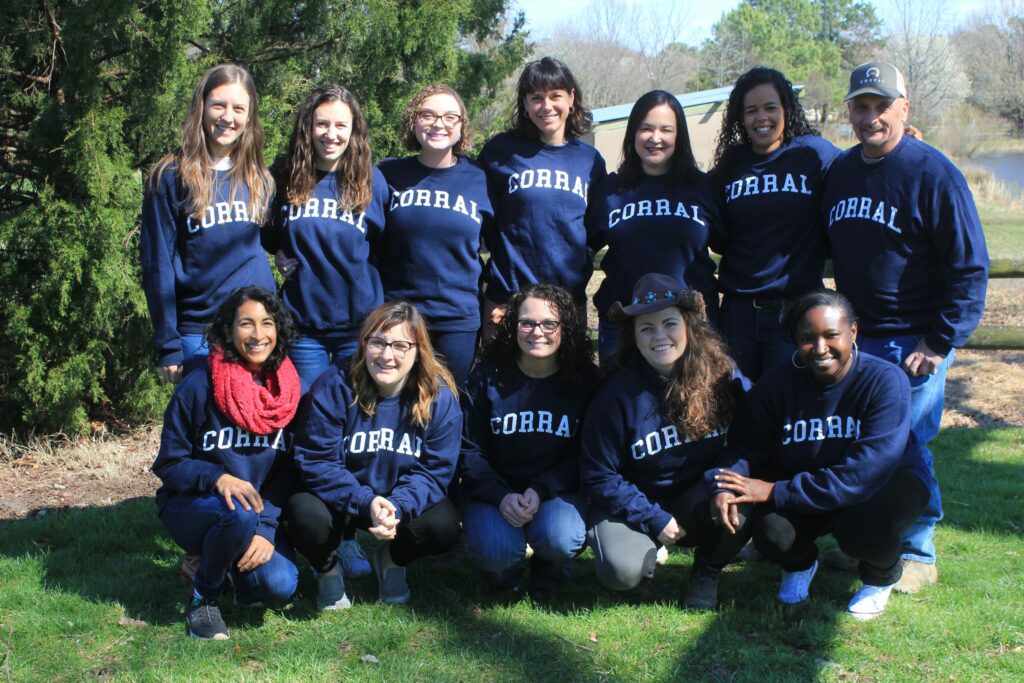By Sharon Holland, the Townsend Ludington Distinguished Professor in American Studies at the University of North Carolina at Chapel Hill.
It is a Friday morning, and I am up early to ride. Summer is waning and you can feel that cool breeze under the hot one that says autumn is on its way, along with the first leaves of the season falling from the Ash trees all around us. As I brush my horse, the dust filters through the sun and her skin ripples, all copper, from my touch – in true form, she relaxes a bit shifting her weight from one leg to another. Barn sounds of water buckets and fresh hay; music and purposeful conversation find their way over to us from the first aisle and I am glad that I worked my way back to this sport/place that African descended people in this country like me helped to create almost three hundred years ago.
The 1773 Legendary Race
Sometime around 1773, the country’s first sport was officially launched on the North Carolina/Virginia border. Thousands gathered to lay bets on a race that has become legendary. One Austin Curtis, the enslaved African-descended jockey and groom for trainer and owner (horses and humans), and North Carolina planter, Willie Jones won the high stakes race on the back of a quarter horse gelding. As two enslaved men, one named Austin, the other Ned, careened around the ¼ mile track, Curtis lost his stirrup purposefully, easing the experienced Ned into a complacency that allowed Curtis to take the lead. On the edges of the American Revolution, this inter-colony race set the stage for a contest that would be often repeated in the history of the sport. Enslaved, rarely freed, people groomed, rode, and eventually trained some of the most illustrious names in horse racing. We have often made the mistake of using their enslaved status to discount both their love of horses and their impact upon the equestrian pursuits many of us are involved in centuries later. That they were human chattel under the law is irrefutable, that they thought of themselves and the animals they worked with and loved in this way is clearly not the case.
History shows us that these race horse men were from a long line of skilled horse men dating back to the Malinke people of northern West Africa, whose prowess with horses was well known in the 17th century. It is often understood that enslaved Africans came to this country and learned their trade here, but that misconception is proved false when we look at the irrigation systems engineered by enslaved peoples in South Carolina that are still functioning today or when we dissect the sport of racing and begin to see vestiges of a skillset brought to the sport. For every horse rubbed or poultice administered, I can think of a young stable hand named Jimmy Winkfield as a young man, rubbing horses with tonics and potions used for over a century by the time he found himself in a Kentucky stable as a teenager. The great Jimmy Winkfield was the last great African-descended jockey to win the Kentucky Derby (1913). He lived an incredible life – after he and many of his kind were cheated in close finishes or literally kicked off their mounts, he went to Russia where his fame as a jockey only increased and on the eve of the first World War, he found himself in the middle of the Bolshevik revolution driving over 252 thoroughbreds to safety over three months and eleven hundred miles.
A Rich History of African-Descended Jockeys
In the early days of the sport, even before that 1773 race, African-descended jockeys were so ubiquitous that folks who bet on the contests were suspicious of a race if the jockeys who showed up were white. It is the madness of the world of slavery that winnings were sometimes cash, tobacco, or enslaved beings, even as members of the very same group mounted their race partners and brought home the purse. But before Winkfield’s last win at the Kentucky Derby, these men, first enslaved and then freed after formal emancipation, brought the “American” seat, later called the “Hunt” seat to equestrian life; before this safer, better-for-the-horse seat came about riders sat on their horses bolt upright, in the English seat.
At the time of the sport’s beginnings, African descended jockeys and stories of their genius were well-circulated in barns and stables throughout horse country. If you were a fan of racing, you would have heard of the feat of one Black jockey named Cato riding the five-year old roan horse, Wagner in a match race with white jockey Stephen Welch on the silver Grey Eagle. The 1839 race brought Cato and his horse to the attention of famed Swiss born artist Edward Troye, whose paintings of some of the country’s most exquisite athletes and at times, the enslaved men who rode, trained, and groomed them from the early to mid-19th century are some of the only visible records that we have of our contributions to this sport. Cato won his freedom that day in the biggest race in Kentucky history before the Civil War.
But even before Troye’s time, America’s first sport caught the attention of then Major General Andrew Jackson, who in 1811 bought a stake in a racehorse only to watch a 4’ 6” Black jockey named “Simon,” continue to beat his horse on the back of an impressive finisher and mare named “Maria.” Known for his sarcasm and its bite, Simon quipped to the man who would be President: “I’ve rode a good deal agin [sic] your horses, but none were ever near enough to catch my spit.” Probably one of the few African descended persons, enslaved or otherwise, who could say such a thing to a white man and get away with his life.
After the Civil War, with the coming of formal emancipation, Black jockeys’ rode in the first Kentucky Derby (1875), with Oliver Lewis taking the race on Aristides. The running of the Derby not only solidified the changing of the racing guard from the North in New York to the South in Kentucky, but also announced the sure dominance of African-descended riders in the sport. Two years later at seventeen, Black jockey Billy Walker would mount Baden Baden for the Derby win in 1877. This reconstruction era of phenomenal equestrian sport birthed the nation’s first bona fide sports star, Isaac “Ike” Murphy, who dominated the sport until the turn of the century. The success of the jockeys also saw the success of Black trainers like Ed Brown, who saddled Baden Baden and developed other horses who would ride in the Derby over his thirty years in the business. While Murphy and other stars rose, tensions between Northern & Southern jockey clubs increased, with predominantly white jockeys in the North and Black jockeys in the South, riling white patrons and owners of the Northern establishments. As reconstruction gave way to the firm grip of the Jim Crow South, Black jockeys received fewer mounts, were locked outside jockey clubs and if they did catch a ride here or there, they were literally kicked from their horses or battered so badly in the far turns that they could not hold onto the seat they had created or, in some cases, the love of the sport they helped to engineer. Their prominence and the tragedy of their lived experiences is captured in the novel by Harlem Renaissance writer Arna Bontemps, God Sends Sunday (1931).
Honoring Ancestors Through Riding
Early in my return to North Carolina, I rode at a barn with the following sign displayed above the tack room bulletin board: “Children left unattended will be sold as slaves.” It wasn’t one of those paper signs that frays over time, but made of tin, like a street sign. Built to last. The cruelty of that sign is undeniable, but the terrible irony of its placement – in a barn, in North Carolina, just a few counties over from where, over two-hundred years ago, African-descended people established what is now commonly known as “the sport of kings” – is so very apparent. It is to the genius of the enslaved that we owe a debt of gratitude every time we rub a horse’s neck or position a saddle over the withers. My people taught me how to communicate with another being and how to achieve some modicum of freedom together. When I ride my chestnut quarter-horse mare on the soil of this place called North Carolina, I am doing so much more than riding; I am connecting with a slew of ancestors who taught us how to ride and continue to teach me how to ride each and every day. I am grateful and proud to be riding, still and to honor this legacy that they left for us – it is the one place in my life where I can ask someone of European descent, perhaps with the wry wit of Cato signing in my ear: “I know what brought me here, but do you?”
References:
- Joe Drape, Black Maestro: The Epic Life of an American Legend (New York: Harper, 2006).
- Edward Hotaling, The Great Black Jockeys (New York: Forum – Prima Publishing, 1999).
- Pellom McDaniels, The Prince of Jockeys: The Life of Isaac Burns Murphy (Lexington: University Press of Kentucky, 2013).
- Katherine C. Mooney, Race Horse Men: How Slavery and Freedom Were Made at the Racetrack (Cambridge: Harvard University Press, 2014).
- James Robert & Monica Renae Saunders, Black Winning Jockeys in the Kentucky Derby (Jefferson, North Carolina: MacFarland & Co., 2003).
- Lawrence Scanlan, The Horse God Built (New York: St. Martin’s Griffin, 2007).
- Jessica Dallow “Narratives of Race and Racehorses in the Art of Edward Troye,’ in Equestrian Cultures: Horses, Human Society, and the Discourse of Modernity, Kristen Guest & Monica Mattfeld, eds. (Chicago: University of Chicago Press, 2019).





